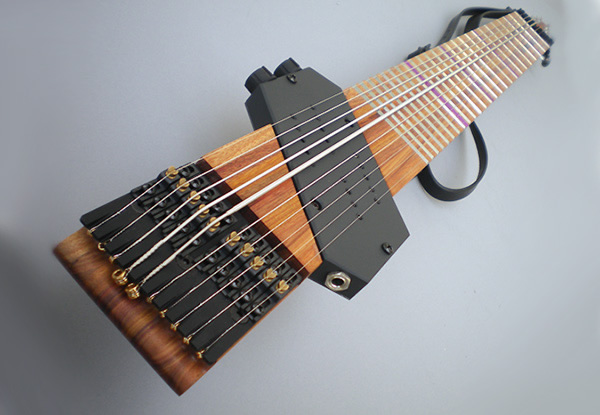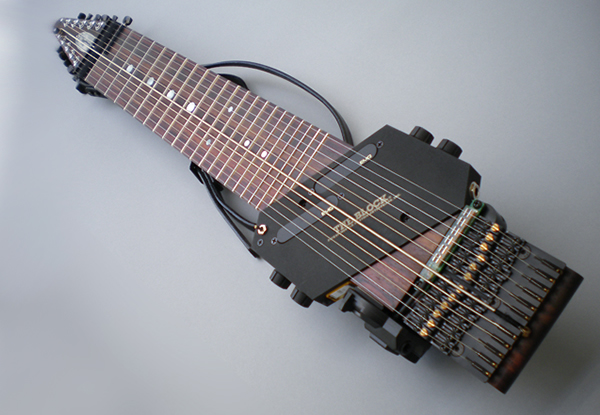Chapman Stick
Electronic Instruments
America
Between 1901 and present
Video
The Chapman Stick is a fascinating and innovative stringed instrument that has significantly influenced contemporary music. Invented in the 1970s by musician and engineer Emmett Chapman, this instrument offers a fresh approach to playing music by utilizing a tapping technique that allows performers to create complex and harmonically rich compositions. Unlike traditional stringed instruments like the guitar or bass, the Chapman Stick is designed for both hands to independently play melodies, chords, and basslines simultaneously. Its versatility, unique structure, and groundbreaking playing method make it an essential instrument in progressive rock, jazz fusion, and experimental music.
Description and Type of Instrument
The Chapman Stick belongs to the family of electric stringed instruments and is often classified as a touchboard instrument due to its distinct playing technique. Unlike a conventional guitar or bass, where strings are plucked or strummed, the Chapman Stick is played by tapping the strings against the frets with the fingers, a method known as “two-handed tapping” or “touch-style playing.”
The instrument consists of a long, wide fretboard with eight, ten, or twelve strings, depending on the model. It is typically played in an upright position, either strapped to the player’s body or mounted on a stand. The Chapman Stick’s design allows musicians to perform basslines and melodies simultaneously, effectively functioning as both a guitar and a bass. Additionally, the instrument is equipped with active or passive pickups, enabling electric amplification and various sound modifications.
There are different variations of the Chapman Stick, including:
- The Standard Chapman Stick – Typically featuring ten strings and tuned in a combination of bass and melody strings.
- The Grand Stick – Featuring twelve strings, allowing for extended range and greater harmonic possibilities.
- The Stick Bass – A shorter-scale version of the instrument with eight strings, designed specifically for bassists.
- The Alto Stick – A smaller variant tuned to higher pitches, ideal for lead melodies and lighter tonal qualities.
- The NS/Stick – A hybrid model designed in collaboration with Ned Steinberger, featuring eight strings and the ability to be played with both tapping and conventional plucking techniques.
History and Origin
Continent and Century
The Chapman Stick originated in North America, specifically in the United States, in the late 20th century. Emmett Chapman, a jazz guitarist and innovative musician, developed the instrument in the early 1970s as a result of his explorations with new playing techniques. The invention of the Chapman Stick marked a significant departure from conventional stringed instruments and introduced a completely new way of playing music.
Development and Evolution
Emmett Chapman began experimenting with a unique tapping technique in the late 1960s. He modified his electric guitar to facilitate a two-handed tapping method, which allowed both hands to play independently on the fretboard. This experimentation led him to design an entirely new instrument optimized for this playing style.
In 1974, Chapman introduced the first commercial model of the Chapman Stick and began producing them under his own company, Stick Enterprises. The instrument quickly gained attention among musicians interested in exploring new sonic possibilities. Over the decades, Chapman continued refining the design, introducing various models and expanding the instrument’s capabilities.
Since its inception, the Chapman Stick has found a place in numerous genres, including progressive rock, jazz fusion, classical, and world music. Its unique playing style has influenced countless musicians and has been embraced by artists seeking to expand their musical vocabulary.
Types and Features
The Chapman Stick is available in several variations, each designed to accommodate different playing styles and musical needs. While the standard model features ten strings, other configurations offer alternative ranges and tonal possibilities.
String Configurations
The Chapman Stick typically comes in three main configurations:
8-string models – Designed primarily for bass players or those who prefer a more compact instrument.
10-string models – The most common configuration, balancing bass and melody strings for versatile playing.
12-string models – Expands the instrument’s range, providing even greater harmonic possibilities.
Tuning
One of the key features of the Chapman Stick is its unique tuning system. The instrument is commonly tuned in a mirrored fourths and fifths arrangement, where the bass strings are tuned in ascending perfect fourths, and the melody strings are tuned in descending fifths. This tuning allows for wide chord voicings and facilitates complex harmonic interplay between the hands.
Common tunings include:
Classic tuning – The standard tuning for ten-string models, offering a balanced range.
Matched reciprocal tuning – A tuning variation that provides symmetry between the bass and melody strings.
Baritone melody tuning – Adjusts the melody strings for a deeper, richer tone.
Construction and Materials
Chapman Sticks are made from various materials, including hardwoods like maple, rosewood, and wenge. Some modern models incorporate composite materials for enhanced durability and lighter weight. The instrument’s fretboard is usually extended in length, allowing for a broad range of notes and making it possible for players to perform basslines, chords, and melodies seamlessly.
The instrument is also equipped with specialized pickups, either active or passive, which help shape its distinctive sound. Players can connect the Chapman Stick to amplifiers, effect processors, and other electronic equipment to further expand its sonic capabilities.
Work Mechanics and Playing Technique
The Chapman Stick’s unique playing technique is one of its most defining characteristics. Unlike traditional stringed instruments that rely on plucking or strumming, the Chapman Stick is played using a tapping technique that enables musicians to create complex textures and intricate harmonic structures.
Two-Handed Tapping
The instrument’s design allows each hand to operate independently, with one hand typically playing basslines while the other performs melodies or chords. This technique enables a player to produce polyphonic arrangements, effectively playing multiple parts simultaneously.
The left hand usually taps bass notes and chords, laying down the harmonic foundation. The right hand is responsible for playing lead melodies, arpeggios, and chord voicings. This method allows a single musician to perform compositions that would normally require multiple instrumentalists. The Chapman Stick’s ergonomic design facilitates this technique, making it easier to execute rapid note changes, smooth transitions, and dynamic expression.
Role in Music
The Chapman Stick has played a crucial role in expanding the possibilities of modern music. Its ability to function as both a bass and melody instrument makes it a valuable tool for musicians across various genres.
Progressive Rock and Jazz Fusion
The Chapman Stick has been widely adopted in progressive rock and jazz fusion, two genres that emphasize technical proficiency and musical experimentation. Artists such as Tony Levin, known for his work with King Crimson and Peter Gabriel, have popularized the instrument within these styles. The Chapman Stick’s ability to produce intricate textures and rich harmonies has made it a favorite among musicians looking to push the boundaries of conventional music.
Classical and Experimental Music
In classical and experimental music, the Chapman Stick has been used to explore new compositional techniques. Its broad range and polyphonic capabilities allow musicians to perform complex arrangements that blend elements of traditional and contemporary music. The instrument’s adaptability makes it a valuable asset for composers and performers seeking innovative soundscapes.
Significance of the Chapman Stick
The Chapman Stick holds a special place in the history of musical instrument development due to its revolutionary approach to playing stringed instruments. By introducing a two-handed tapping method, Emmett Chapman changed the way musicians approach stringed instruments, opening new possibilities for solo performances and ensemble playing. From progressive rock to classical music, the Chapman Stick’s versatility has allowed it to find a home in multiple musical styles. The instrument has influenced numerous musicians and composers, contributing to the evolution of contemporary music.
The Chapman Stick remains a groundbreaking instrument that continues to inspire musicians worldwide. Its unique design, playing mechanics, and broad musical applications ensure its lasting significance in the ever-evolving world of music.
FAQ
What is the primary playing technique of the Chapman Stick?
The primary playing technique of the Chapman Stick involves tapping the strings against the fretboard with both hands, rather than plucking or strumming them. This method allows for independent musical lines to be played simultaneously.
How does the Chapman Stick differ from traditional guitars in terms of sound production?
The Chapman Stick differs from traditional guitars in that it produces sound through tapping rather than plucking, and it is designed to play multiple parts simultaneously, such as bass lines and melodies. This polyphonic capability is unique compared to standard guitars.
What types of materials are used in the construction of modern Chapman Sticks?
Modern Chapman Sticks are constructed from a variety of materials, including hardwoods like padauk and mahogany, organic materials such as bamboo, and advanced composites like graphite epoxies. This diversity in materials allows for different aesthetic and tonal options.
 Links
Links
References
Other Instrument
Categories



















